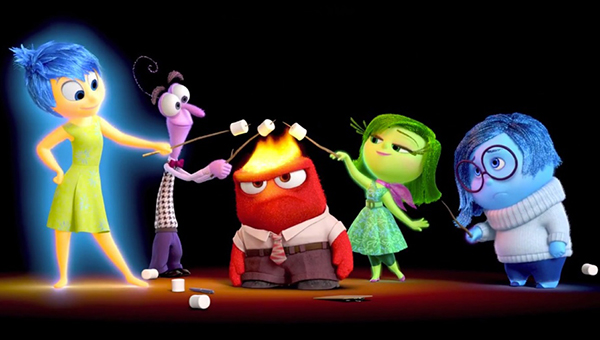Inside Out Review

Upon observing a sudden change of character in his own daughter around the age of 11, director Pete Docter began a little research and learned that the most emotionally astute demographic is 11-17 year old girls.
From this notion came the seeds of eleven year old Riley and the five emotions that live in her Headquarters and steer her through the daily experience of life, resulting in the latest bauble on the Pixar tree, Inside Out.
Leading the team of emotions is Joy, a 21st Century Tinkerbell and the heart of Riley’s character. Around Joy are the emotions that make up Riley: Anger, Fear, Sadness and Disgust.
Joy has seen to it that Riley has had a wonderful life, but that all changes when Riley’s parents move the family to San Francisco, causing a crisis in headquarters.
None of the emotions know how to carry Riley through this unprecedented situation, and cannot work out what Riley should feel, so she is thrown into confusion. Cue Anger, Fear and Disgust knocking Joy from her post as Riley’s lead emotion.
One by one the lights go out on the Islands of Personality as Joy and Sadness find themselves out in the wasteland of Riley’s memory bank, Joy desperately trying to keep Sadness from touching the memories as once she does it will become sad when Riley thinks of it.
So Joy has to find their way back to Headquarters before Riley loses all the islands that make her who she is.
Just in case you’re hoping cute pixies are pulling the joysticks of your daily feelings, Docter states that Inside Out does not purport to be in any way scientific.
There is most certainly a Studio Ghibli feel to this addition to Pixar’s oeuvre; the story is an exploration of a moment in a young girl’s childhood.
However, movingly, the focus isn’t on the happy bubble of innocence, but on its loss; the realisation anyone who’s grown up has had: that things as you knew and loved them have gone forever, before you’ve developed the capacity to understand.
Inside Out is very funny, but it also overflows with sadness; one cannot fail to be touched by the emotions’ quest to help Riley understand the world as it suddenly expands and looms large and threatening.
Both the idea and its execution are highly imaginative and the concept is certainly unique, presenting us with a new level of creative maturity.
I find Pixar’s films richer the older I get, and there is so much to delight in in watching Inside Out, in particular, the variance in all the worlds created , as there are many in Inside Out. The real world inhabited by Riley and her parents and Riley’s Headquarters being the two main settings.
There are many poignant moments throughout the film, particularly with Riley’s imaginary friend Bing Bong, and Joy’s moments alone with an armful of Riley’s core memories of early childhood. As we get older, we cannot fail to be touched by sadness, but should not a touch of joy be ever present?
Inside Out is highly imaginative, boasts a remarkable and moving score and, of course, is beautiful to behold. The designs of the emotions are clever, each in some way portraying something related to their job.
So Disgust resembles broccoli, and Sadness is teardrop shaped.
The animation gets more and more beautiful too, with the colouring around Riley’s face during a sudden outbreak of tears touchingly realistic, her face reddening in all the right places.
Everything stands on the foundation of a strong and unique story, so the quality of animation, the designs, the lighting, the worlds and the music add layers of icing to a cake that is already delectable as served.
Children will delight in the imagery, Riley’s hopes, fears and frustration with her parents as well as the personified emotions; Anger already seems to be a young favourite. While adults will get all this, with cream on top. Man, it’s great to be older.
Inside Out is Pixar doing what they do best, and doing it wonderfully.
EJ Robinson